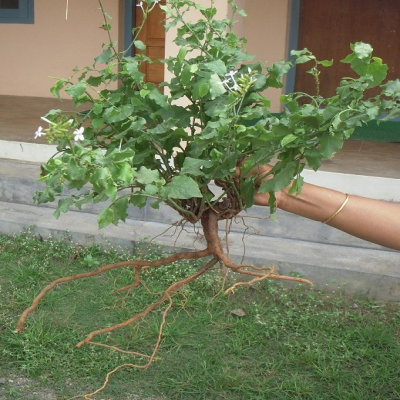Distribution and habitat: Found wild in peninsular India and mostly in West Bengal. It is a branched under shrub.
Botany: Perennial, sub-scandent shrubs, 60-120 cm high.
- Roots : Long and tuberous. Stem is striate.
- Leaves : Simple, alternate, short petioled, ovate or ovate-oblong, acute with entire or wavy margin, 7x3.8 cm and glabrous.
- Flowers: White, arranged in terminal spikes. Calyx is tubular, glandular-hairy. Corolla tube is slender; limb rotate and 5 lobbed. Stamens are 5 on a disc. Style is slender with 5 stigmatic branches.
- Fruits : Membranous capsule enclosed within the persistent calyx.
- Seeds: Oblong.
Properties & Uses:
- The leaf is anti-rheumatic.
- Root is appetiser, sudorific, relieves pain, vasicant, diuretic, caustic, anti-diarrhoeal and expellent of phlegmatic tumours. Root is uterine stimulant.
- Root and fruits have anti-implantation activity. Plumbagin induces anti-implantation, has abortifacient and anti-ovulatory activity and causes selective testicular lesions in dogs. It is also a mitotic inhibitor. In lower concentrations it behaves like a spindle poison but in higher concentrations it exhibits radiomimetic, nucleotoxic and cyclotoxic effects.
- It also has antibacterial, antifungal and anticoagulant activities and shows antagonism to amphetamine hyperactivity in mice.
- Root is used externally in leprosy and other skin diseases or obstinate character, aphthae, abscesses, influenza, piles and anasarca.
- Juice is used externally in scabies and ulcers.
Chemical constituents: The roots of P. zeylanica have been exhaustively studied and naphthaquinones have been isolated, namely, plumbagin, 3-chlroplumbagin, droserone, 3, 3’-biplumbagin (Chitranone), zeylanone and iso-zeylanone and a coumarin, elliptinone. It also contains 1, 2 (3)-tetrahydro-3, 3’-biplumbagin and plumbazeylanone.
Formulations: The well-known preparations are Chitrak Adivati and Chitraka Haritaki. In unani system it is an ingredient of Aqaruva-i-Kabir, Hab Ashkhar, Ma’jun Baladur, Ma’jun Raig Mahi, etc.
Agrotechnology
Propagation: By vegetative methods
Manuring: Cattle manure or compost @ 10 t/ha may be applied as basal dose at the time of land preparation. The fertilizer dose is N:P2O5: K2O is 50:50:50 kg/ha
Harvesting: 18 months after planting.

